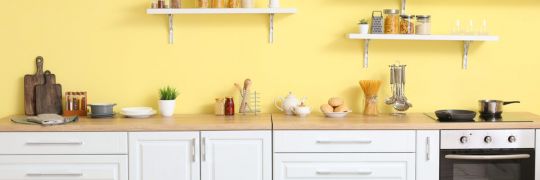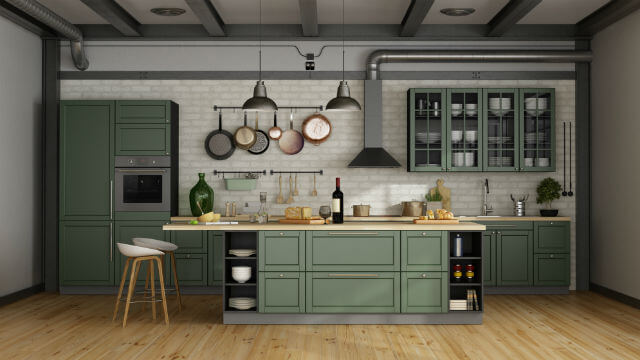7 factors in a kitchen design plan

What should you consider in designing your dream kitchen? We cover 7 steps to think about, plus share some financing options.
7 factors to consider with designing your dream kitchen
Plans for your kitchen redesign should give thought to the space and layout of the room, your preferred design style and visual appeal, durability of fixtures and finishes, choice of appliances, and functional storage solutions. Here are 7 factors to contemplate in designing your dream kitchen:
- Budget
- Space and layout
- Design style
- Colour palette
- Fixtures and finishes
- Appliances
- Storage solutions
1. Budget
As with any renovation project, it’s important to work out how much you want to spend and how you will fund the work. Options could include paying cash, refinancing your home loan or applying for a new construction or personal loan.
2. Space and layout
First and foremost, it is important to think about the space you are working with. For some, an open plan U-shaped kitchen with an island breakfast bar is the perfect solution. While for others, a single-wall or gallery kitchen might be the optimal choice to make the best use of the space. One thing to consider when determining the desired layout for your space is the flow and functionality of the room. Ensure there is enough continuous benchtop space for comfortable food preparation, plenty of floor space to accommodate multiple cooks, and well thought out placement of appliances.
3. Design style
Choosing a design style for your kitchen is a very personal choice, but something to take into account is how it will tie in with the style of the rest of the house. For example, a modern farmhouse kitchen with a deep porcelain sink might be a popular style choice, but it might not be the best fit for an ultra-chic inner-city apartment. Other popular decor choices include a contemporary style with minimalist design elements, Shaker style featuring distinctive recessed-panelled cabinetry, and industrial style with stainless steel benchtops and open shelving.

4. Colour palette
Your kitchen’s colour palette should ultimately be reflective of the design style you choose. It is common to see kitchens with a fairly neutral or monochromatic colour scheme, which is a particularly safe choice from a resale perspective. However, there has been an increase in the popularity of jewel-toned kitchens, such as emerald green and sapphire blue.
For a more sophisticated touch, choices could include navy blue, hunter green and deep plum. And if you’re not ready to go all out, think about choosing a colour for the lower cabinets and leaving the upper cupboards a bright white or other complementary neutral shade.

5. Fixtures and finishes
There can be a lot weighing on the materials you choose to use in your kitchen, with a particular emphasis on benchtops. Kitchen benches are a very prominent visual feature, and in addition to this, they will likely come into contact with an endless amount of food and liquid, as well as cooking equipment in a range of different colours and temperatures. For this reason, it is important to choose your benchtops for not only their aesthetic appeal, but for their durability. Marble, for example, is a strikingly beautiful material for kitchen benchtops, but it may require much more considered use and upkeep as it is softer and more porous than other options such as manufactured stone and laminate.
Then there’s the splashback, a hard surface applied a wall, usually adjacent to the sink or stovetop. Material options for a splashback could include coloured glass, a sheet of stainless steel or decorative tiles. Tapware can also make a big impression, and there are many styles on the market from which to choose, from shiny stainless steel to brushed metals and coloured metals such as black or rose gold. Whatever it is that you select, ensure you consider the durability of the material as well as the ease of cleaning and upkeep.
6. Appliances
With such a vast range of appliances on the market, you really are spoilt for choice when fitting out your new kitchen. The basics include a fridge, cooktop (with an overhead rangehood/extraction fan and light), oven and microwave. More luxurious options include a double oven, wine fridge and built-in coffee machine.
Do your due diligence and make decisions based on the elements most important to you – whether they be budget, quality and energy efficiency. It’s also important to ensure that they are the right size to fit into their corresponding space in your kitchen cabinetry. While you should ideally look to buy appliances that will last for years to come, they tend to be the easier items to upgrade in a kitchen. That’s because they are often standard sizes and can often be pulled out of existing cabinetry and replaced without expensive alterations.
7. Storage solutions
Storage is a vitally important consideration in any kitchen’s design. Something that is too often overlooked in the design of a kitchen is the practicality of the storage options. The pantry will be the most frequented cupboard in the kitchen, and so in turn should be prioritised when planning. For those with the luxury of space, a walk-in pantry or butler’s pantry might be a desirable option, but there are plenty of space-saving alternatives that can function just as well, such as vertical, pull-out pantry units, under-bench drawers or tall, stand-alone cupboards with shelving.
Taking the time to carefully consider each aspect of a kitchen remodel will allow you to design one that fits your needs – both aesthetically and practically – as well as your budget. You might be surprised how enjoyable the process can be, and how rewarding it is to relish the final product.
What are the options to finance a new kitchen?
Before you dive into the work, thinking about the most suitable way to pay for your renovation is an essential step. Depending on your situation, your options could include:
- Paying out of your own pocket: You could consider using your savings if you have enough reserves;
- Personal loan: Depending on your personal circumstances and the cost of the job, you may consider using a personal loan to fund the work. This could be a secured loan, or an unsecured loan. It’s worth keeping in mind, though, that interest rates are generally higher for personal loans than for home loans, and it’s a good idea to read the lender’s terms and conditions first.
- Home loan: If this job is big enough, or you are doing a range of jobs at the same time, one choice you may consider is refinancing or restructuring your home loan, or adding a “line of credit”. For example, depending on your lender, you may be able to add a redraw facility to your existing loan (although it’s wise to keep in mind that some fees could apply to any loan changes and there could be redraw limits). Or, you could add an offset account, which could help reduce the interest paid on your loan while still allowing access to your money (although it’s wise to keep in mind there could be some fees involved here, too, and higher interest rates could apply to these types of loans).
Compare Home Loans (Refinance with variable rate only) with Canstar
If you’re currently considering a home loan, the comparison table below displays some of the variable rate home loans on our database with links to lenders’ websites that are available for homeowners looking to refinance. This table is sorted by Star Rating (highest to lowest), followed by comparison rate (lowest to highest). Products shown are principal and interest home loans available for a loan amount of $500,000 in NSW with an LVR of 80% of the property value. Consider the Target Market Determination (TMD) before making a purchase decision. Contact the product issuer directly for a copy of the TMD. Use Canstar’s home loans comparison selector to view a wider range of home loan products. Canstar may earn a fee for referrals.
The comparison rate for all home loans and loans secured against real property are based on secured credit of $150,000 and a term of 25 years.
^WARNING: This comparison rate is true only for the examples given and may not include all fees and charges. Different terms, fees or other loan amounts might result in a different comparison rate.
 Owner occupied
Owner occupied
 20% min deposit
20% min deposit
 Redraw facility
Redraw facility
 Owner occupied
Owner occupied
 20% min deposit
20% min deposit
 Redraw facility
Redraw facility
 Owner occupied
Owner occupied
 10% min deposit
10% min deposit
 Redraw facility
Redraw facility

Up to $4,000 when you take out a IMB home loan. Minimum loan amounts and LVR restrictions apply. Offer available until further notice. See provider website for full details. Exclusions, terms and conditions apply.
 Owner occupied
Owner occupied
 20% min deposit
20% min deposit
 Redraw facility
Redraw facility
 Owner occupied
Owner occupied
 10% min deposit
10% min deposit
 Redraw facility
Redraw facility
Canstar is an information provider and in giving you product information Canstar is not making any suggestion or recommendation about a particular product. If you decide to apply for a home loan, you will deal directly with a financial institution, not with Canstar. Rates and product information should be confirmed with the relevant financial institution. Home Loans in the table include only products that are available for somebody borrowing 80% of the total loan amount. For product information, read our detailed disclosure, important notes and additional information. *Read the comparison rate warning. The results do not include all providers and may not compare all the features available to you.
Home Loan products displayed above that are not “Sponsored or Promoted” are sorted as referenced in the introductory text followed by Star Rating, then lowest Comparison Rate, then alphabetically by company. Canstar may receive a fee for referral of leads from these products.
When you click on the button marked “Enquire” (or similar) Canstar will direct your enquiry to a third party mortgage broker. If you decide to find out more or apply for a home loan, you can provide your details to the broker. You will liaise directly with the broker and not with Canstar. When you click on a button marked “More details” (or similar), Canstar will direct your enquiry to the product provider. Canstar may earn a fee for referral of leads from the comparison table above. See How We Get Paid for further information.
Main image source: By Pixel-Shot/Shutterstock.com
This article was reviewed by our Digital Editor Amanda Horswill and Sub Editor Jacqueline Belesky before it was updated, as part of our fact-checking process.

The comparison rate for all home loans and loans secured against real property are based on secured credit of $150,000 and a term of 25 years.
^WARNING: This comparison rate is true only for the examples given and may not include all fees and charges. Different terms, fees or other loan amounts might result in a different comparison rate.

Up to $4,000 when you take out a IMB home loan. Minimum loan amounts and LVR restrictions apply. Offer available until further notice. See provider website for full details. Exclusions, terms and conditions apply.
 Owner occupied
Owner occupied
 20% min deposit
20% min deposit
 Redraw facility
Redraw facility
Try our Home Loans comparison tool to instantly compare Canstar expert rated options.
The comparison rate for all home loans and loans secured against real property are based on secured credit of $150,000 and a term of 25 years.
^WARNING: This comparison rate is true only for the examples given and may not include all fees and charges. Different terms, fees or other loan amounts might result in a different comparison rate.







